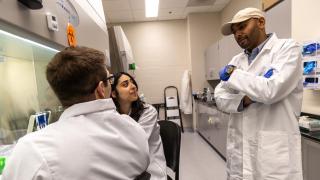
The past few years have taught us that even in a state with an abundance of fresh water, access to safe drinking water isn’t something to be taken for granted. The headlines have been hard to miss, from the Flint water crisis and water shutoffs in Detroit, to stories about aging water infrastructure, toxic algae blooms, and PFAS contamination. So how do we cope with such a wide range of serious challenges — and continue to deliver citizens safe, affordable drinking water? U-M Professor of Civil and Environmental Engineering Nancy G. Love says it will require rethinking the basic functions, design and values that underlie our urban water systems. She recently led a virtual discussion on the topic for our ongoing Strategic Planning Thought Leaders Series, and we’ve summarized a few of the big takeaways, in case you missed it.
How your water system works now
First things first: Since the vast majority of our water system remains out of sight, it’s worth recapping how it works. Most centralized public water systems are made up of two interconnected components. The first is a drinking water treatment facility, which draws water from the environment. For the big system serving much of Southeast Michigan, the water intakes are on the Detroit River and Lake Huron. We then treat that water through a variety of physical and chemical processes until it’s safe to drink and send it out via a distribution system of underground pipes. When you wash dishes, take a shower, or flush the toilet, that water and everything in it enters the second big system component: the wastewater system. A separate set of distribution pipes transports the wastewater to a treatment facility, which treats the water to remove solids, like human waste, pollutants, and dissolved nutrients, like phosphorus (more on that below). When the treatment process is complete, the water is returned to the natural environment and the cycle starts all over again.
Infrastructure challenges in Midwestern cities
Love says these large centralized systems, which serve the vast majority of Americans, are incredibly effective. But our water systems are facing some huge challenges. One of the biggest is age. In older cities in the East and Midwest, the large underground pipes are often a hundred years old — twice the life they were designed for. Replacing them will be critical in the near future, but it will be incredibly costly. Unfortunately, Love says, federal spending for water systems has steadily declined since the 1970s, shifting the financial burden to local governments. To compound problems, many Midwestern cities have lost population, leaving fewer customers to pay for a growing list of repairs and updates.
The public health dimensions of our water systems
Interestingly, the combined challenge of aging infrastructure and fewer people to pay for it isn’t just a financial problem. Love argues it can also lead to public health issues. When a water system that was designed for a larger population now has fewer residents using it, one of the consequences is that water sits in the distribution pipes longer. This is called “water age,” and typically, Love says, you only want your water to be a day or two “old.” In shrinking cities like Flint, however, Love says, water age can be weeks. This gives harmful biological pathogens, like Legionella (which causes Legionnaires' disease), much more time to re-establish themselves as the disinfectants we add, like chlorine, gradually lose effectiveness. Love says the coronavirus pandemic has also put a spotlight on the public health implications of water shut-offs in Detroit. “In 2018, almost 18,000 Detroit households were at risk for water shut-offs,” Love says. “And just before the pandemic shutdown, there was a point made by several officials in the state that there is no proof that water shutoffs harm health. I think now we’re in a very different place. Water shut-offs are being reversed, and I think this has brought to the forefront a discussion that this is not the way to handle this.”
Wastewater systems as nutrient recovery systems
We don’t normally think of it this way, but wastewater is packed with useful stuff. In particular, nutrients essential to life, like carbon, nitrogen and phosphorus, are all abundant in wastewater. The original source for much of that, Love says, is the food we eat, which enters our wastewater system through human waste. The problem is the majority of those nutrients are never removed from wastewater before it’s put back into the environment. The result? Excess nitrogen can cause “dead zones” in marine environments; while excess phosphorus has been linked to the harmful algal blooms plaguing Lake Erie. Removing those nutrients — and even reprocessing them into products like fertilizers — can be done, but our current systems for doing so are inefficient and energy intensive. “About 80 percent of the nitrogen, 60 percent of the phosphorus and at least half of the pharmaceuticals in wastewater come from our urine,” Love says. “What we do with it today is dilute it — a lot: About 1 percent or less of wastewater is urine, then we send it to a treatment plant, then we pump a lot of energy in to remove that nitrogen. That’s very inefficient.” Love says one solution is to keep urine from entering the wastewater system in the first place through new technologies like waterless urinals and urine diverting toilets. In fact, at U-M, they have a processing facility that turns undiluted urine from waterless urinals into nitrogen that can be used as a fertilizer — completing the nutrient cycle, while using much less energy than conventional wastewater systems.
Water systems for the future
Love says our large, centralized water systems have taken us far as a society. They’ve basically stamped out many waterborne diseases that were common in the early 20th century. Their “one-size-fits-all” approach provides access to the vast majority of Americans. And they’re an unsung engine of our economy. But going forward, she argues augmenting these systems with new approaches could make our water safer, more affordable, more sustainable and more efficient. Technologies like urine diverting and composting toilets, combined with small, contained treatment systems for processing waste onsite, could be solutions for office buildings, apartment complexes or single-family homes. Similarly, onsite systems that separate black, gray and yellow water could help us recycle nutrients more efficiently. Love is also piloting projects where water customers could report crowdsourced water quality data — allowing treatment centers to adjust their safety protocols in real time. “I also think our systems need to be more visible,” Love says. “Smart thermostats have made us much more connected to our energy use. What’s the comparable technology for water and nutrients? We don’t have that. But I would argue that’s what we want. We want them on a common platform so that water, energy and nutrients are all aspects of our living we interact with and help optimize.”





